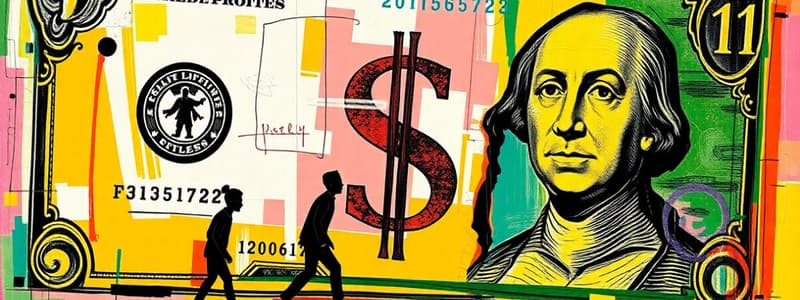Podcast
Questions and Answers
What are the primary materials that have historically been used as money?
What are the primary materials that have historically been used as money?
- Silver and bronze
- Gold and silver (correct)
- Silver and platinum
- Gold and copper
What characteristic does good money primarily need to possess?
What characteristic does good money primarily need to possess?
- It must have a complex design
- It must be scarce and hard to copy (correct)
- It must be easily breakable
- It must be heavy and bulky
What invention helped solve the problem of knowing how much gold or silver one possessed?
What invention helped solve the problem of knowing how much gold or silver one possessed?
- Bank notes
- Digital transactions
- Paper currency
- Coins (correct)
Why do people consider gold and silver special beyond their monetary value?
Why do people consider gold and silver special beyond their monetary value?
What is typically included on a real coin to indicate its authenticity?
What is typically included on a real coin to indicate its authenticity?
What does the term 'thaler' originally refer to?
What does the term 'thaler' originally refer to?
Which problem did the invention of money warehouses aim to solve?
Which problem did the invention of money warehouses aim to solve?
What is a Silver Certificate in the context of past U.S. currency?
What is a Silver Certificate in the context of past U.S. currency?
What caused the U.S. dollar to lose its popularity after the 1960s?
What caused the U.S. dollar to lose its popularity after the 1960s?
What was Kublai Khan's legal tender law designed to do?
What was Kublai Khan's legal tender law designed to do?
Which of the following statements about Federal Reserve Notes is true?
Which of the following statements about Federal Reserve Notes is true?
During the Revolutionary War, what happened to Continental dollars?
During the Revolutionary War, what happened to Continental dollars?
What consequence did refusing to accept paper money have in 1790s France?
What consequence did refusing to accept paper money have in 1790s France?
What does the phrase 'legal tender' refer to?
What does the phrase 'legal tender' refer to?
What was the original meaning of the British Pound Sterling?
What was the original meaning of the British Pound Sterling?
Flashcards
What is Money?
What is Money?
The most easily traded item. It must be easily moved, have a clear value, be desired by many people, be durable, scarce and hard to copy.
Why is gold and silver the best form of money?
Why is gold and silver the best form of money?
Gold and silver are the best forms of money because they meet all the requirements of being valuable and easily exchanged. They are easily moved, have a clear value, are desired by many people, are durable, scarce and hard to copy.
What makes a coin valuable?
What makes a coin valuable?
Coins are valuable because they're made of gold or silver. They also have a stamp that tells the weight, purity, and name of the mint they were made at.
What is a hallmark?
What is a hallmark?
Signup and view all the flashcards
Is a paper bill a dollar?
Is a paper bill a dollar?
Signup and view all the flashcards
Coin Hallmark
Coin Hallmark
Signup and view all the flashcards
Joachimthaler
Joachimthaler
Signup and view all the flashcards
Thaler
Thaler
Signup and view all the flashcards
Dollar
Dollar
Signup and view all the flashcards
Commodity Money
Commodity Money
Signup and view all the flashcards
Money Warehouse
Money Warehouse
Signup and view all the flashcards
Banknote
Banknote
Signup and view all the flashcards
Legal Tender
Legal Tender
Signup and view all the flashcards
Fiat Money
Fiat Money
Signup and view all the flashcards
Inflation
Inflation
Signup and view all the flashcards
Study Notes
Dollar's History and Evolution
- A dollar isn't a piece of paper; it's an ounce of silver.
- Gold and silver have been used as money for millennia due to their durability, scarcity and wide desirability
- Money must be easily traded, portable, widely accepted, and resistant to corrosion.
- Many unusual items have been used as currency, including stones, cattle, beads, salt, fish, and shells.
- Coins solved the issue of determining the weight and purity of gold or silver by stamping the weight, fineness, and mint's name on them.
- The Joachimthaler, a one-ounce silver coin, was widely used in the Middle Ages, leading to the term "thaler", later shortened to dollar.
- Other currencies are also based on weights of precious metals (e.g., pound sterling, French franc, shekel).
- Money warehouses (banks) provided a safe place to store money.
- Banknotes (IOUs) represented stored precious metals, evolving into paper money in the US.
- Until the 1960s, US dollars were "Silver Certificates," redeemable for silver.
- Today's US dollar is a "Federal Reserve Note," not backed by precious metals; its value comes from a legal tender law.
Legal Tender and Fiat Money
- Kublai Khan used legal tender laws to force acceptance of paper money (fiat money) in exchange for goods.
- The French government used similar methods, enforcing paper money's acceptance with extreme measures.
- US legal systems have a similar "legal tender" system.
- The "legal tender" status makes US dollars accepted in payment, in most circumstances, preventing refusal without penalty
Inflation and the Value of Money
- Inflation occurs when a government prints too much paper money without sufficient precious metals to back it.
- Historical examples show that inflated paper money loses value, while stable, convertible currencies retain their worth.
- The value of money is determined by people's willingness to accept it in trade.
- The author attributes economic problems to corruption in the legal system, suggesting that an idealized system isn't supported by contemporary legal frameworks.
Studying That Suits You
Use AI to generate personalized quizzes and flashcards to suit your learning preferences.




